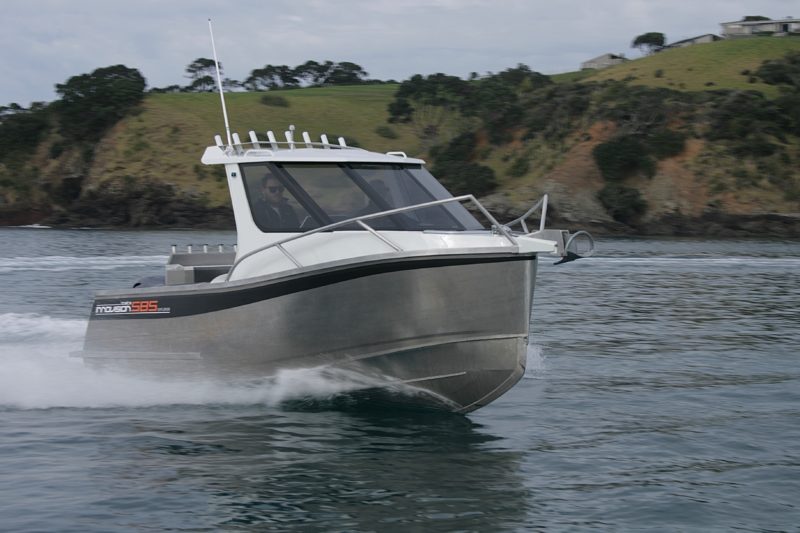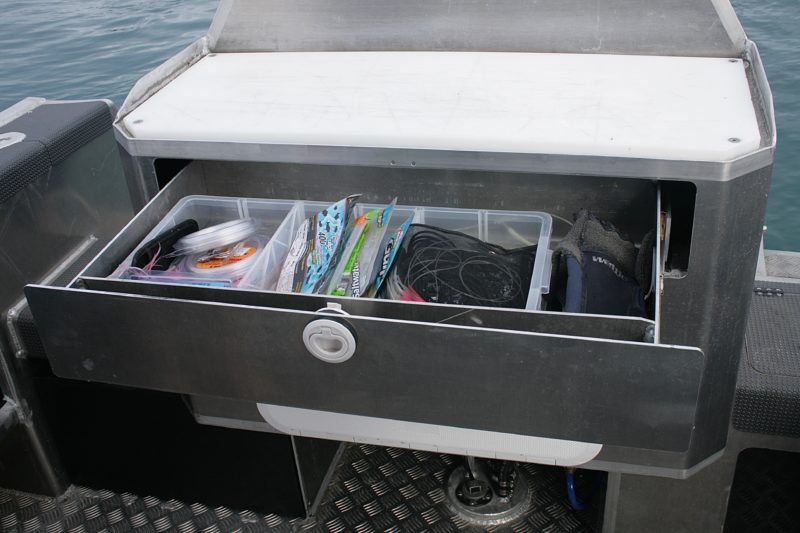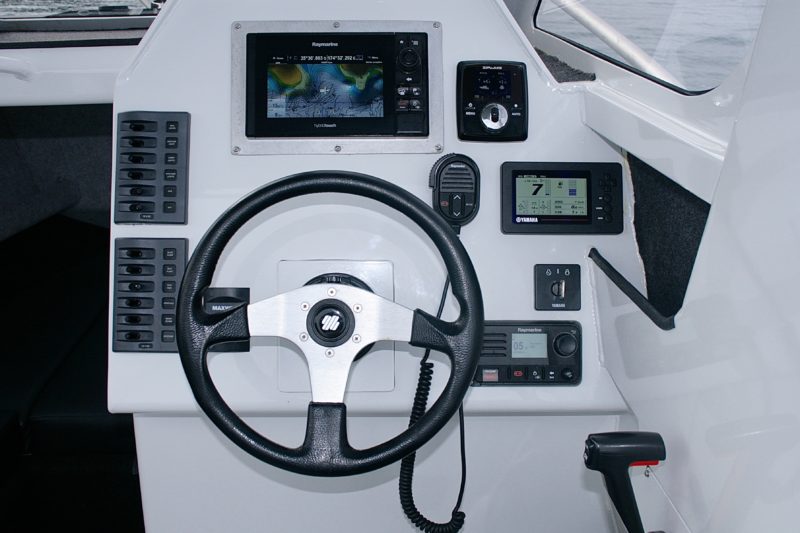Building seven boats in just over three years might not sound a lot but, when you are a young boat builder going up against some very big players, it is a damn good start.
Unlike many a newcomer to the crowded New Zealand aluminium trailer boat market, Simon Minoprio didn’t study what was currently working and then try to emulate it. Quite the opposite. He took virtually no notice of the existing pace-setters and instead, using his experience in competitive international yacht racing and his love of fishing and trailer power boating, created a design very much his own — one he believes will best suit Kiwi boaties and the conditions they encounter.
Founded just over three years ago, Simon’s INNOVISION Boats has now exhibited at the past four Hutchwilco New Zealand Boat Shows and built — and sold — seven designs. It may not sound like a lot, but Simon is very happy with his progress. At least for the time being, he is not interested in creating a production boatbuilding business. His passion is in matching boats to clients. Every design is, largely, a custom one and, of the seven so-far completed boats, only two have been of the same model.
This is not to say that there is no continuity between the designs. There most definitely is. All are very clearly INNOVISION boats. All boast Simon’s trademark plumb bow. All have his equally distinctive reverse sheer topsides (the transom at the waterline is wider than at the gunwales). And all are exceptionally good at handling the nasty, messy chop we so often encounter in our coastal cruising grounds.

The Innovision 585 Explorer is boat number 6 (the 515, which we used as a camera boat, is number 7. A review of it is scheduled to appear later this year).
It is, says Simon, aimed at those looking for what he calls “a big little boat”. By that he means a relatively small boat (easy to power, garage and tow) that can almost literally go anywhere: take on a bar; head out to the Mokes or Great Barrier and not have to worry about getting home if things cut up rough, or even journey up the Three Kings. If that last sounds far-fetched, it’s not. The 585’s owner is, right now, planning just such a trip.
Like the rest of Simon’s designs, the 585’s “larger than life” performance is due in large part to its distinctive plumb bow. As numerous big boat and yacht designers have discovered in the past, a bow that drops virtually straight down to waterline rather than receding sharply back under the foredeck has a number of compelling advantages.
Chief among them is the obvious one: it increases the usable waterline without increasing the LOA. This means the 585 boasts the sort of waterline length that would usually be found on a boat of 6.5 or even 7m. It also allows Simon to design what he believes is the finest entry of any aluminium boat of this size. This, that extra long waterline and that yacht-like knuckle at the bottom of the stem, give the 585 a ride that really does belie its sub-6-metre LOA.
Gentle ride
Arranging to go for a ride on the 585 was no simple matter. It is based in Tutukaka and the weather on Northland’s east coast in July and August was either atrocious or too flat for Simon’s liking. We finally got a day with enough light for the camera and enough lumps for Simon. Leaving the calm waters of the harbour, we headed out through the heads to find a messy chop of about a metre peak to trough. It was the sort of water that doesn’t look too bad at first glance but which can quickly end up giving a pretty jarring, uncomfortable ride, especially at speed.

Luckily, someone forgot to mention this to the 585.
Although the owner had fitted a clever-looking Zipwake trim tab system, I found it easier to leave it off and just use the Yamaha 130hp to make any adjustments. Despite the high hardtop and the reasonable breeze, the 585 seemed remarkably unaffected by either, remaining relatively upright regardless of the angle of attack. The ride was remarkably soft, even at speed and even when heading upwind into the chop. Beam on, the hull shape and Ultraflex hydraulic steering (standard on all INNOVISION boats) meant there was virtually no need to keep hands on the wheel. Downwind, even at speed, there was no need to trim the bow up, the tracking was true and just a little feathering was required to power out of the troughs.
Turning around in the messy water was also not a problem and it quickly became apparent that there was little if anything that was going to faze this vessel.
Reversing back into the oncoming breeze did see us ship a little water and those intending to chase big game in reasonable seas might want to consider adding scuppers rather than just relying on the bilge pump.
Regarding ground-covering, Simon says a speed of around 22 knots seems best. At 4400rpm, the Yamaha 130hp four-stroke outboard gives 1.1 nmpl which, combined with the 585’s 175-litre fuel tank, means a rather impressive range of around 200 nm.
Simple, practical
The 585 Explorer is pretty obviously a boat designed and intended to go fishing, perhaps with a little diving thrown in. With the exception of the hardtop (inside and out), the dash and the seats, the finish is bare alloy. Although a rarity at a time when most alloy boats appear to be doing their best to look like GRP ones, Simon says his owners simply don’t see the point in painting areas that are likely to get “beaten up”. For those serious about their fishing it is an appealing philosophy; harking back to a time when one of the main attractions of an alloy boat was that one didn’t have to treat it with kid gloves.

This “designed to be used and used hard approach” is found throughout the cockpit. The floor is treadplate. The gunwale rod lockers (4 a side) are welded flush in the coaming. The ladder is a basic, two-step affair. The seats are of the box variety with a simple squab on top and drop-down aft-facers behind. Even the “luxury” touches — the anti-skid on the coamings and transom steps, and the carpet in the side lockers — are there for practical reasons, not aesthetic.
This is not to say there are no clever touches. There are. The deluxe bait station is a good example. An island affair with a step to the platform on either side it is a full metre wide. It comes with five-rod holders across the back, a near full-width permanently-mounted thick plastic bait board with a surrounding gutter for easy cleaning and drainage out onto the platform. It also boasts a carpeted, compartmentalised pull-out tackle drawer complete with an easy close catch and sealed to keep water, bait juices and like out.
Another nice touch is the long underfloor dry locker. Fully sealed, it contains two pull out plastic bins (the larger one for the catch, the smaller for the bait). Simon says this not only makes unloading and cleaning far easier, but it also keeps the salt ice frozen for much longer. “I can’t believe how quickly it melts on bare aluminium,” he says.
A similar plastic box lives under the starboard transom seat while, over on port, is the obligatory live bait well. Under the tackle drawer is the battery locker, safely high out of harm’s weigh, big enough for a second battery and featuring a handy DC bus.

The side lockers, running all the way from the transom to the cabin bulkhead are both long and wide enough to carry all the rods, gaffs, boat hooks and the like one is likely to need. There is also a wash down hose, neatly coiled in its own alloy tube, at the aft end of the port locker.
For those who like to rest on the coamings while waiting for the fish to bite, Simon has set these up to slope slightly outward, which many will find more comfortable than if they were completely horizontal.
Under the hardtop
While the simple, practical theme continues under the hardtop, there’s plenty of what matters: handy open stowage lockers, headroom, handrails, footrests and protective antiskid. There’s also good all-round visibility and the cut-away design means there is no need for opening side windows.
The helm is compact and neat with a Raymarine eS78 HybridTouch MFD, running hydrographic charts, in pride of place on the dash. There are twin Blue Seas DC panels and the Maxwell RC6 windlass control down the port-hand side with the Zipwake and Yamaha panels on starboard above a Raymarine VHF. The Yamaha throttle lever is of the flush mount variety and a set of Blue Seas outlets (DC and USB) are close at hand, useful for both charging and for running spotlights and the like. A large flat carpeted area over the cabin is a good resting place for things like paper charts, cellphones, sunglasses, etc.

In the cabin there is good stowage under the seats and in the side lockers. There is also provision to mount a toilet on the starboard side, directly behind the helm, where there would be a measure of privacy.
The squabs are 1.85m long and there is an infill that creates a giant berth if required. There is also good headroom for those who want to sit here and a slimline Vetus hatch gives ventilation, light and access to the foredeck, should it be needed.
Angled returns at the base of the hardtop ensure water flowing down from the bow is directed outboard rather than into the cockpit. There are 8-rod holders in the rocket launcher (meaning 21 in total) and LED lights mounted on the aft corners of the hardtop brightly illuminate the cockpit if required.
Summary
The INNOVISION 585 Explorer is a fascinating mixture of bold, modern innovation and rugged, old school simplicity. Simon’s years of competitive yacht racing combined with a long love of fishing in our boisterous coastal seas has led him to design a series of trailer boats that are distinctly different. Where others focus on good looks and cramming as many features as possible into the available space, he comes from a different angle. For him, seakeeping, a soft ride in hard seas and a super-sturdy construction are the priorities.

It is probably not an approach likely to lead to mass production. It is, however, one that is slowly building an almost cult-like following, especially among those who rate function over form, soft riding over a pretty appearance and ability to go virtually anywhere over just about anything else.




